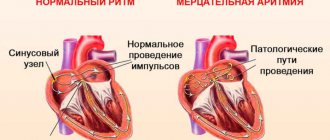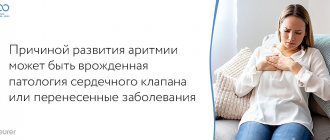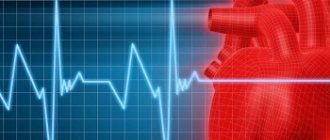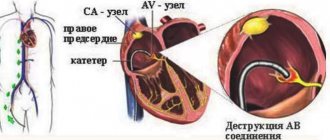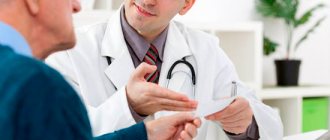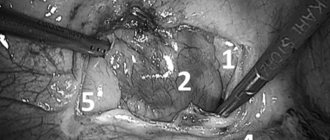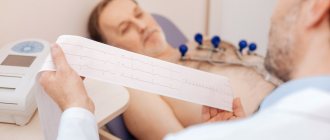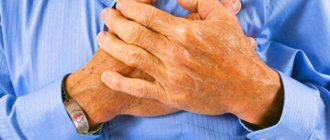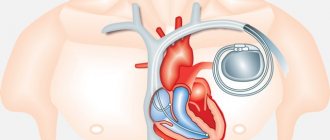Are rapid heartbeats, chest pain and shortness of breath preventing you from living a full life? Arrhythmia may be the cause of your discomfort. Arrhythmia is disturbances in heart rhythm that occur as a result of other disorders in the body.
The normal heart rate for a person under the age of 60 is 60-80 beats per minute. The heart muscle contracts at regular intervals, so a person gets used to it and does not notice his heartbeat. Deviations from the norm are accompanied by a rapid pulse and irregular contractions. Or it may be completely asymptomatic. Therefore, the presence of arrhythmia and its type can only be determined using instrumental diagnostics. Arrhythmia occurs more often in men over 60 years of age. However, in rare cases it also occurs in children.
Why is arrhythmia dangerous?
The disease occurs as a result of disturbances in the conduction system of the heart, which ensures sinus rhythm - regular contractions of the myocardium. Contractions of the heart muscle originate in the sinus node and spread through the myocardium of the right atrium to the atrioventricular node. It turns out to be less excitable, so the atria contract first, only then the ventricles. Without timely diagnosis and treatment, arrhythmia causes angina attacks, heart failure, pulmonary edema and even cardiac arrest.
Causes of cardiac arrhythmia.
The disease occurs both as a result of other cardiac pathologies and for reasons not related to the functioning of the heart. The first group includes:
- cardiac ischemia;
- previous myocardial infarction;
- cardiomyopathy (changes in the size and shape of the heart);
- congenital and acquired heart defects;
- myocarditis (inflammatory diseases of the heart muscle);
- arterial hypertension;
- injuries and wounds of the heart, including surgical ones;
- heart failure;
- cardiosclerosis.
As a result of these diseases, the heart muscle is damaged. The conduction system of the heart suffers, and the normal propagation of the electrical impulse of the heart to its various parts becomes more difficult. Sometimes the lesion affects the sinus node.
Arrhythmia can also be caused by:
- vegetative-vascular dystonia;
- tobacco and alcohol abuse, intoxication;
- heavy or excessive physical activity;
- febrile conditions in infectious diseases;
- disorders in the endocrine system;
- the influence of stress, the presence of neuroses;
- exhausting mental or physical work;
- metabolic disorders of electrolytes important for the heart (potassium, magnesium, sodium, calcium).
As a result of the influence of these factors, defects form in the heart muscle, due to which it cannot function normally and conduct electrical impulses along damaged nerve branches.
Atrial fibrillation
Sometimes it happens that a person’s heart is pounding very, very hard in his chest, beating like a bird in cages. And sometimes it beats and then becomes silent for a while. From a medical point of view, this phenomenon is called cardiac arrhythmia, as a result of which the movements of the heart muscle are disrupted from the desired rhythm. There are different types of arrhythmia, but atrial fibrillation is especially common.
It has been established that each heartbeat represents a gradual contraction of the muscles of various parts. This begins with contraction of the atria, after which the muscles of the ventricles contract. Only this sequence represents the correct functioning of the heart. If a person suffers from an arrhythmia with the interesting name “atrial fibrillation,” then one stage of the sequence disappears, or rather, atrial contraction is not observed. The muscles of these parts of the heart gradually lose the ability to move coherently, so the atria make some chaotic contractions, as they say, flicker. This rhythm disturbance also causes a disruption in the cyclicity of ventricular contraction.
Causes of atrial fibrillation
A large number of causes have been identified that cause atrial fibrillation. First of all, we should mention all kinds of heart diseases, such as heart defects, heart failure, coronary heart disease, infectious heart damage and myocardial infarction.
Excessive alcohol consumption can also be considered a cause of atrial fibrillation. They even use such a concept as “holiday arrhythmia.” Regardless of the calendar, attacks of arrhythmia can occur in people suffering from thyroid diseases, in particular with its increased function, as well as other hormonal imbalances.
It is not uncommon for arrhythmia to occur in people who have suffered a stroke, stressful situations or surgery. Taking certain medications is also a risk factor in this case. There is an observation that when using diuretics for the purpose of weight loss, the self-medicating person is sent straight to hospital for treatment. There is a very high risk of developing arrhythmia in diabetics, especially if there are complications such as obesity with hypertension. There is also a genetic predisposition to the manifestation of atrial fibrillation, transmitted from parents to children. In fairness, it should be noted that very rarely doctors are able to accurately and reliably determine the causes of the disease.
It is very important to recognize the appearance of atrial fibrillation in time. Symptoms include unusual heartbeats, in which the heart feels like it’s about to burst out of the chest. Even the person himself feels a disturbance in the rhythm of the heartbeat. Most often, arrhythmia develops unnoticed by the patient. Only feeling the pulse can help determine the presence of an abnormal heart rhythm. Very often, atrial fibrillation is determined by the results of an examination performed in a hospital using an ECG. In the worst case, the presence of atrial fibrillation is revealed by the complications that appear.
The danger of this disease is that it is often accompanied by tachycardia, the so-called increase in the frequency of repetitions of the cardiac cycle. In such conditions, the heart experiences a very heavy load, which is dangerous for its health. This can lead to chest pain, which is a sign of a heart attack or angina. Arrhythmia leads to a deterioration in the efficiency of the heart, and as a result, heart failure.
Arrhythmia can be a temporary phenomenon as a reaction of the body to certain influences or stress. In this case, it may go away over time. However, if the arrhythmia persists for more than a few hours or if any complications occur, you should immediately contact a specialist. Even if the arrhythmia goes away without medical intervention, it is also necessary to consult a doctor. An attack of arrhythmia can recur at any time, and this can lead to health problems and can even become a threat to life. That is why you should not get carried away with self-medication.
Treatment of arrhythmia is most effective within the first 24 hours from its onset. It will be possible to get rid of arrhythmia later, but this will require additional preparatory measures. Atrial fibrillation is a cessation of contraction of the atrium muscles, as a result of which blood flows through them at a lower speed, forming blood clots, the so-called accumulations of clotted blood. Blood clots form already on the second day of arrhythmia manifestation. If normal heart rhythm is restored, the atrial muscles begin to work properly again, and some of the blood clots can penetrate the vessels of the internal organs and clog the lumen. Most often, blood clots penetrate the blood vessels of the brain, resulting in a possible stroke.
Due to this danger, if a patient seeks medical help after 24-48 hours from the onset of arrhythmia, it is necessary to take special medications that slow down the blood clotting process. It will be possible to resolve the issue of restoring heart rhythm only after the start of the action of the above-described drugs after approximately 1-2 weeks of taking them.
Heart rate restoration
Often, restoration of heart rhythm is carried out using special antiarrhythmic drugs. To obtain the effect, they should be used intravenously. In some cases, the patient can take medications in the form of tablets, which are pre-selected by the doctor to prevent an attack of atrial fibrillation. At the moment, no special indicators have been identified, the analysis of which would determine the dosage form that is more effective. During the treatment process, it becomes necessary to test different drugs in order to find the optimal solution for a particular patient.
In real life, there are also difficult situations when atrial fibrillation does not go away under the influence of medications, and a threat to the health and even life of the patient appears. Then there is a need to restore the heart rhythm with a special electrical cardioversion. The procedure involves putting the patient to sleep for a couple of minutes. At this time, at a certain stage of the cardiac cycle, an electric current is applied to the heart, as a result of which the heart rhythm is restored. This method of treatment is somewhat complicated and inconvenient, since the patient must be put into a sleepy state, and complex medical equipment is also required for the procedure. This measure can only be carried out in a hospital setting with the participation of highly qualified doctors. The advantage of the method is that restoration of heart rhythm can be seen in most patients, while medications help only 60-80 percent of patients. In addition to being effective, the electrical pulse method can also be considered safer for the human body, since medications often cause side effects. If they occur, you should wait some time for the substances to leave the body. Based on the advantages of cardioversion, special medical devices are manufactured, so-called cardioverters, which are implanted under the patient’s skin. These devices instantly detect the occurrence of atrial fibrillation and eliminate it. The use of these devices is currently not very widespread.
After the heart rhythm is restored, the patient should maintain it. It is necessary to identify the pathology of the body that led to the occurrence of arrhythmia and cure it. That is, it is necessary to exclude the manifestation of all causes and factors that lead to the appearance of atrial fibrillation. If arrhythmia occurs quite rarely, then therapeutic methods may not be used. However, in practice, it is often necessary to take medications to prevent atrial fibrillation from developing.
If attacks of arrhythmia are very frequent and occur in a very complex form, then the patient is offered surgical intervention for treatment.
Is prolonged atrial fibrillation dangerous?
Experts divide arrhythmia into two different types. The first type - paroxysmal arrhythmia - occurs in the form of separate attacks. The second type is constant arrhythmia, when the atrial muscles contract chaotically for several years. The permanent form of atrial fibrillation usually does not require procedures to restore normal heart rhythm, although it causes quite complex consequences, especially in the case of tachycardia. Special medications that calm the rhythms come to the aid of patients. If you are wondering about the dangers of constantly taking medications, then we can assure you that refusing treatment will lead to many more complications and harm the health of the body.
Symptoms of cardiac arrhythmia:
- Weakness, accompanied by dizziness, absent-mindedness, drowsiness and headaches. It appears in cases where special efforts are required to perform some action.
- Rapid heartbeat, which feels like a “thrill,” the heart is pounding or “jumping out of the chest.” May be accompanied by strong pulsation in the neck, temples, fingertips, tinnitus and difficulty breathing.
- Pain in the chest, behind the sternum. It can be aching, stabbing, burning. Accompanied by difficulty breathing, cold sweat, and nausea.
- Dyspnea. Breathing becomes frequent and noisy. If shortness of breath occurs at rest or with slight physical exertion, its nature is pathological. It is cardiovascular diseases that lead to insufficient blood circulation. The organs do not receive the required amount of oxygen and accumulate carbon dioxide. Internal organs do not receive the required amount of oxygen. This causes shortness of breath.
Types of arrhythmia:
Atrial fibrillation.
An abnormal heart rhythm during which the atria contract faster than the ventricles. This is a complication due to coronary heart disease. Diseases of the endocrine system can also cause the development of atrial fibrillation. Unlike normal heartbeat, muscle fibers in atrial fibrillation are excited frequently and chaotically. In addition to frequent contractions of the heart muscle, the disease is accompanied by increased sweating, darkening of the eyes, muscle weakness and fainting.
Sinus arrhythmia.
During the disease, the sinus node, the main “engine” of impulses in the heart, is damaged. Because of this, the sinus node begins to malfunction. With sinus arrhythmia, an alternation of rapid and slow rhythm occurs. A common type of sinus arrhythmia occurs, in which during inhalation the heart rate increases, and when exhaling, on the contrary, it decreases. This disease is also called respiratory arrhythmia. The pathology is accompanied by dizziness, severe fatigue, breathing problems, and loss of consciousness.
Atrial flutter.
This is a rapid atrial rhythm, reaching 200-400 beats per minute. The reasons for the deviation may be complications after other cardiovascular diseases, the postoperative period, severe stress, or pathological processes in the body. Accompanied by symptoms such as general weakness, discomfort in the chest or behind the sternum, shortness of breath and sudden attacks of rapid heartbeat.
Assistant surgery
In Russia, about 2.5 million people suffer from atrial fibrillation. But people are used to taking it lightly. Like, so what if the heart beats out of rhythm. Meanwhile, this very common disease in the world can lead to very tragic consequences.
The Bakulev Center uses a surgical method for eliminating atrial fibrillation, which has no analogues in the world. The first unique operations, the methodology of which was completely developed at the center, were carried out here under the leadership of academician Leo Bockeria. The monitors show areas of the heart where arrhythmia originates. A catheter is inserted into the patient through a small incision, which, having reached dangerous places, acts on them, completely destroying the disease. True, this method is possible if the case is not complicated in any way.
In difficult situations, traditional surgical intervention is still used. The task is the same - to stop the arrhythmia. Surgeons say the procedure is more complicated than a heart transplant. The organ is isolated from the circulatory system, temporarily connecting the body to an artificial analogue, they operate, freezing the problem areas, and then return everything back. The success rate of such operations here is close to 100%.
The Bakulev Center is the only clinic in the world where both methods of treating atrial fibrillation are practiced at once. The patient's rehabilitation period is very short. On average, a week after surgery, the patient returns home completely healthy.
Diagnosis of arrhythmia.
If you suspect an arrhythmia, you need to consult a specialist for examination and diagnosis to confirm or refute the diagnosis. A cardiologist examines and treats arrhythmias. Arrhythmia is a dangerous disease, so you should never self-medicate. Any medications can only be prescribed by a doctor. The drug itself, if taken incorrectly, can cause arrhythmia attacks.
At the initial appointment with a cardiologist, the doctor will ask questions about symptoms and the frequency of their manifestations, listen to the heart and measure the pulse. It is important to provide your entire medical history to your doctor. To find out the causes of arrhythmia, you will need to undergo basic tests:
- blood chemistry;
- blood test for clotting.
For further research and to exclude more serious pathologies, you will undergo an instrumental diagnostic study.
Treatment of heart rhythm disorders
Our heart supplies the entire body with blood, delivering nutrients to every cell. Periodically contracting, the heart moves blood flow through the vessels, and these contractions occur due to electrical impulses appearing directly in the heart.
In a healthy person, such impulses occur at specific time intervals. When this electrical system malfunctions, the heart contracts irregularly. It is this disorder of the heart rhythm that is called arrhythmia. methods for cardiac arrhythmias are different and largely depend on its type (cause of occurrence).
This deviation can occur for various reasons, but there are cases when it is not possible to determine the root cause of the heart rhythm disturbance. In addition, the manifestation of arrhythmia may be a symptom of another disease or be considered as a separate type of disease.
Sometimes a person does not even realize that he has a heart rhythm disorder, i.e. the disease does not manifest itself in any way or these manifestations are minimal. But in most cases, the patient feels the occurrence of arrhythmia. Symptoms may include a rapid or slow heartbeat, along with a feeling of fatigue, sudden weakness, shallow breathing and chest pain.
When the arrhythmia continues for several hours or additional complications appear, you need to urgently seek medical help. In any case, a trip to the cardiology department will not hurt.
Methods for treating heart rhythm disorders
Treatment of heart rhythm disorders and methods for detecting them are constantly being improved.
To identify the causes of arrhythmia, the doctor will order an ECG (electrocardiogram). It is also necessary to do an ECG-atropine test, when you are injected into a vein with atropine, which changes the regulation of heart rhythm. An ECG during exercise and an ultrasound of the heart may also be prescribed.
Treatment of heart rhythm disorders is carried out in different ways. Your doctor may simply prescribe certain medications to normalize your rhythm if your arrhythmia is not associated with another cardiovascular disease.
In case of serious anatomical abnormalities of the conduction system, surgical procedures (implantation of a cardiac cardioverter-defibrillator) are necessary. It happens that treatment of cardiac arrhythmia is simply not necessary, because it may go away on its own over time. All studies and treatment process are discussed with the doctor.
New information about arrhythmia is constantly emerging. Therefore, detection and treatment of heart rhythm disorders has become more accessible, and the use of timely measures improves the quality and length of life.
Arrhythmia attacks can be prevented if you know that they occur during increased solar activity (magnetic storms). During this time, try to follow the recommendations of doctors and carry the medicine with you.
Please do not self-medicate!
Remember, only a doctor can determine the diagnosis and correctly prescribe treatment.
